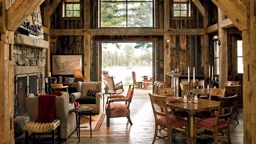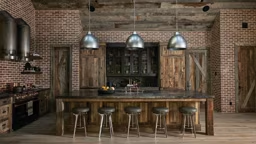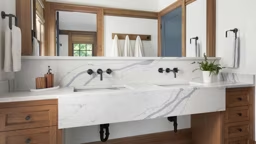
Photo: Estemerwalt Log Homes/Mark Sorenson
Laundry is time consuming. Although much of the task is passive (you simply push a button and the machine does the rest), there’s the gathering, the sorting, the waiting around to transfer the clothes from washer to dryer and then pouncing when that dryer buzzer sounds so you can fold the clothes before wrinkles set in. (Though there’s almost always ironing to do.) And let’s not forget the delicates that require careful hand washing. Yep — laundry day can feel like an all-day affair, and often the laundry room isn’t a space where anyone wants to spend a large amount of time.
But over the past several years, the humble laundry room has gotten the attention it so justly deserves. No longer just a neglected corner holding a washer/dryer, laundry rooms have emerged as spacious, versatile — even glamorous — spaces.
1 Location is Key
Nothing says a laundry room needs to be relegated to a basement. In fact, lugging baskets of clothes around the house is one of the biggest frustrations about this task. If you locate the laundry in a place that makes sense, you can lighten your load; however, the ideal spot in a floor plan varies from home to home, based on your lifestyle.
For instance, some people prefer to place it near the kitchen because that’s where they spend the majority of their time, but builder Mark Carlson of M.W. Carlson, Ltd., in Northbrook, Illinois, says you may want to think twice about putting your laundry room in this spot. “While it may seem convenient, the main level is valuable real estate, and the majority of homes don’t have space to spare for a use like this,” he cautions. “Not to mention that strong food odors can permeate clean clothes. You won’t want tomorrow’s wardrobe to smell like last night’s meal.”
A mudroom between the garage and house is a popular laundry spot for gardeners, families with young kids or folks who like to tinker in a workshop, since you can strip off muddy, greasy duds without tracking debris inside. However, Mark says there are a few downsides to combining the mudroom and laundry. “Say you’ve been washing clothes all day and it’s all stacked in neat piles in the mudroom, ready to be put away. If kids run in and out of this door, not only can they track in quite a bit of dirt, they’re apt to drop soiled clothes right on top of the clean ones,” Mark explains. “So, I’ve always been a believer to keep the washer and dryer out of the mudroom.”
So where’s the best location according to Mark? “Keep the laundry near the bedrooms.” This smart site (even within a large walk-in closet), makes it easy to deposit soiled and cleaned clothes at the source; but washers and dryers can be noisy, so add an extra layer of soundproofing to your walls to keep the din contained.

Photo: Heidi Long
2 Storage is Essential
Having enough storage space for your washday requirements is more than just throwing up a bank of cabinetry and calling it done. In a log or timber home, there’s a good chance even your laundry room will boast soaring ceilings, so use every inch you’ve got. Increase your storage capacity by going vertical, which also will help to visually expand the room’s footprint if the space is small or narrow. Then, when mapping out your storage needs, think about how you will use the room, what products and equipment you’ll keep there and design a system of cabinets, drawers, pullout baskets and open shelving that will maximize the room’s square footage and keep items organized.
3 Factor in Functionality
An efficient laundry room makes the job at hand easier, and there are several keys to accomplishing this feat.
For starters, install sorting bins to keep whites, darks, towels and delicates separate until you’re ready to tackle them. A deep sink comes in handy for soaking or hand-washing garments. A hanging rod or rack elevates air-dried items out of the way, ample counter space allows you to fold with ease, and a retractable or wall-mounted ironing board lets you press clothes immediately.
And while most of us place the washer/dryer on the floor – elevating them on a platform is more ergonomic and will help keep your back intact.

Photo: Whirlpool
4 Make it Multitask
While you’re maxing out functionality, consider expanding beyond the weekly wash. In fact, in today’s log and timber homes, the term “laundry room” really is a misnomer. These spaces have evolved into crafting/project spaces, gift-wrapping centers, sewing rooms, dog-washing stations, potting areas — even mini-offices for bill-paying. As you’re drafting your home’s design, consider all aspects of your daily life and determine how you might use this area to support your lifestyle.
5 Keep it Bright
There are several ways to accomplish this edict. Of course, the first is through lighting. Nothing beats the purity of natural light, so, if possible, position your laundry room along an exterior wall so you can install a window or two (the ability to usher in fresh air will also do you good). Then, layer in artificial light. Overhead ambient lighting is a must, but don’t stop at mere illumination. An attractive fixture — even a chandelier —adds pizzazz and will entice you to linger a little. Don’t forget task lighting beneath wall-mounted cabinets suspended above a folding table, and interject a few accent lamps to set a soothing mood.
In addition to literal light, color goes a long way toward making a laundry room feel bright and open. A neutral color palette, consisting of white, cream and blush, imparts a sense of being “clean” and is a natural complement to any exposed logs or timber framing that may reside here. But Mark says, “Don’t be afraid to add color. Bold tones or accents — even brightly colored appliances or cabinetry — will add a layer of excitement to what’s otherwise a very utilitarian space.”

Get the look and functionality of custom built-ins without breaking the bank with this 4-piece wall-mount cabinetry set. Shop it: Flow Wall®, Wayfair.com
6 Flooring That’s Enduring
The right flooring goes a long way toward designing a laundry room that’s a pleasure to use and easy to maintain. Ceramic or porcelain tile is Mark’s go-to material, thanks to its durability. There are hundreds of colors, styles and patterns from which to choose, they’re easy to clean and, perhaps most importantly, they’re waterproof. It’s also easy to install radiant in-floor heat beneath them, adding an extra helping of comfort to a laundry room.
7 Lifestyle Luxuries
Everything from the size of your family to your career to your favorite pastime can influence your laundry room’s appointments.
For example, if you have a large family, host frequent overnight guests or enjoy laundry-inducing pursuits like fishing or skiing, consider upgrading to more than one washer and/or dryer unit. Running multiple appliances simultaneously will save time — just make sure your water tank is sized to tackle the task. If you have a corporate job that requires you to wear suits daily, save money on pricey dry-cleaning bills by installing a steam-cleaning machine (also handy for sanitizing children’s toys).
If laundry doesn’t exactly pile up in your household or you have frequently washed items (think: exercise apparel), look to washing machines with dual-washing capacity — one drum for larger loads or items like bedding and a second drum that can handle smaller, short-cycle loads.
comfortable as the rest.











